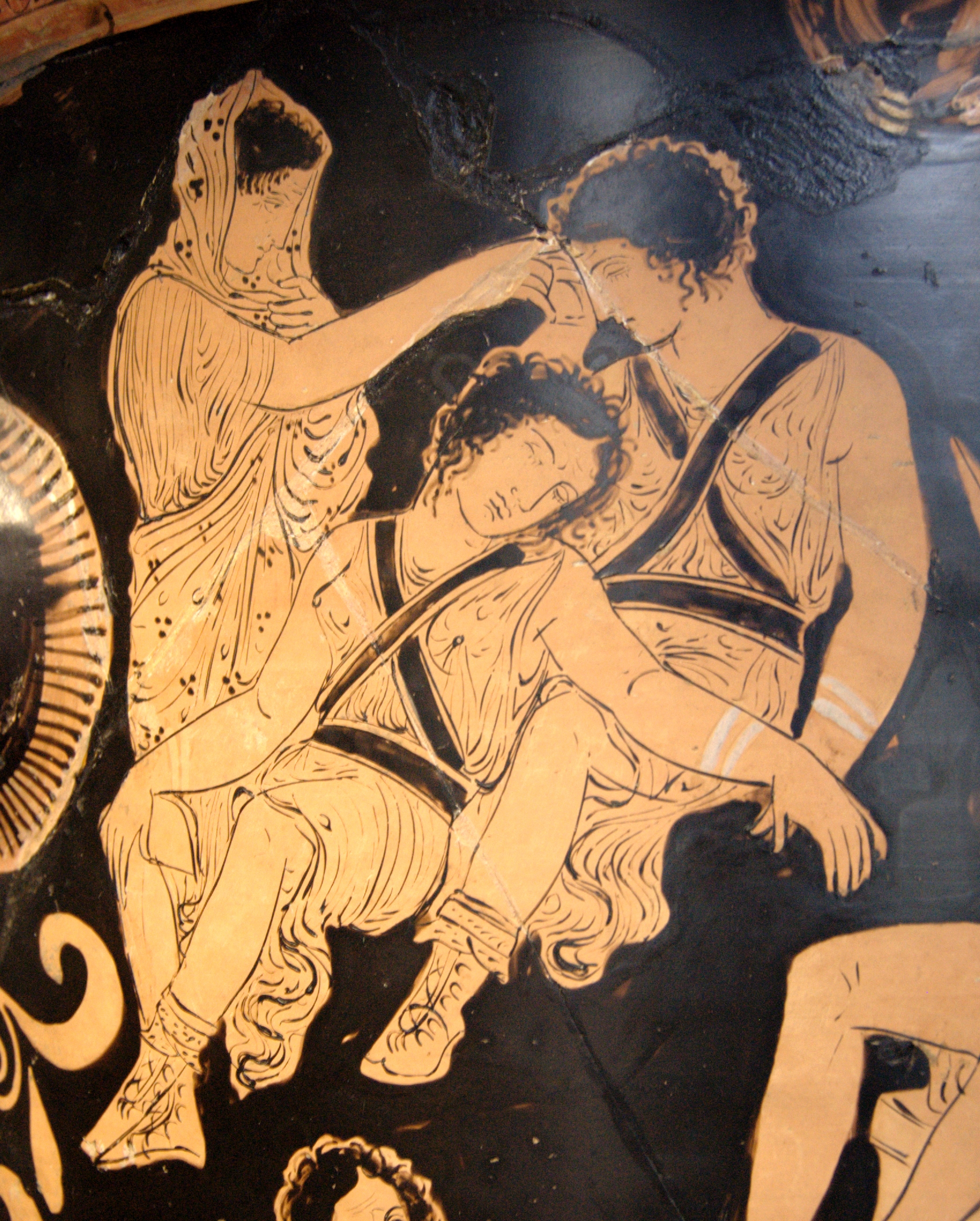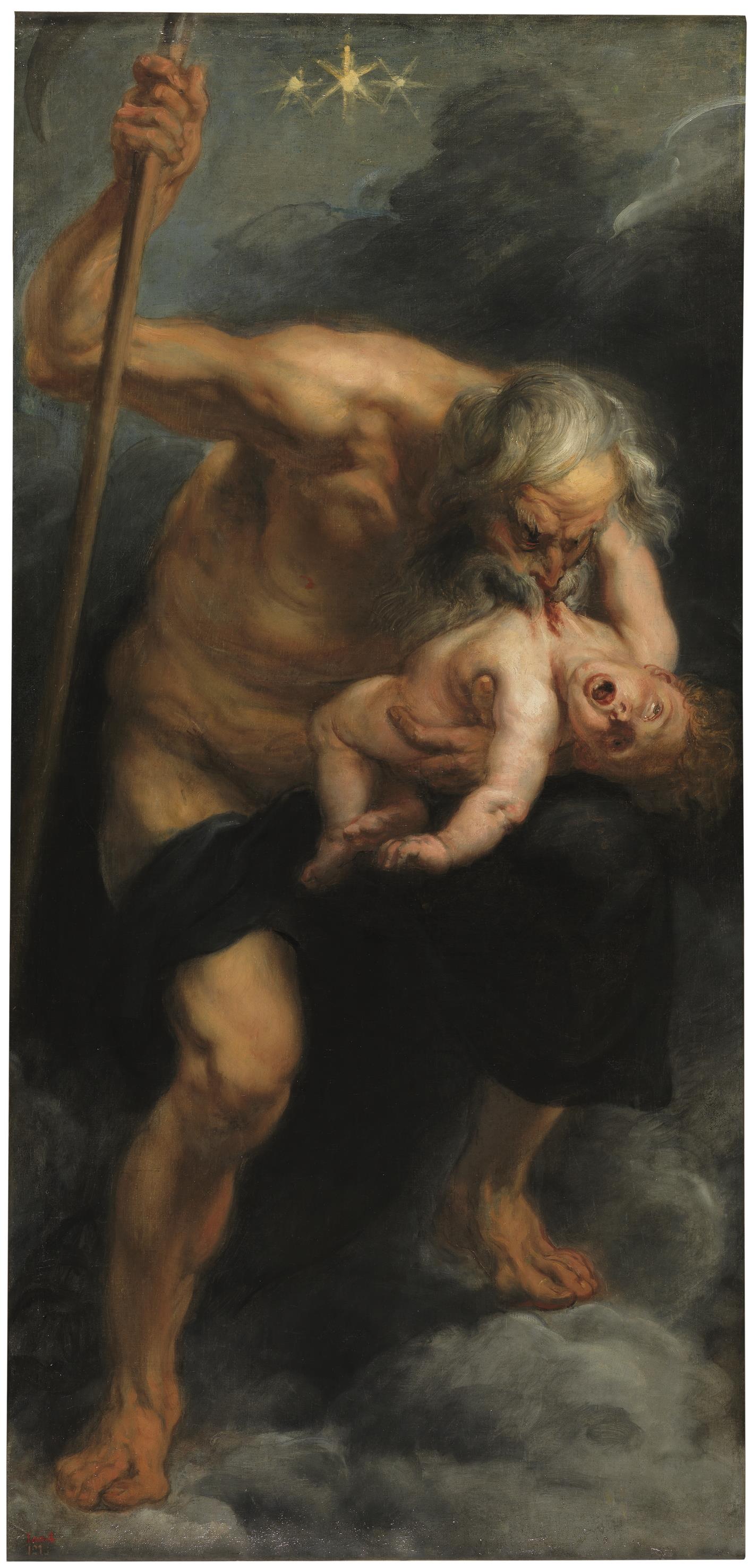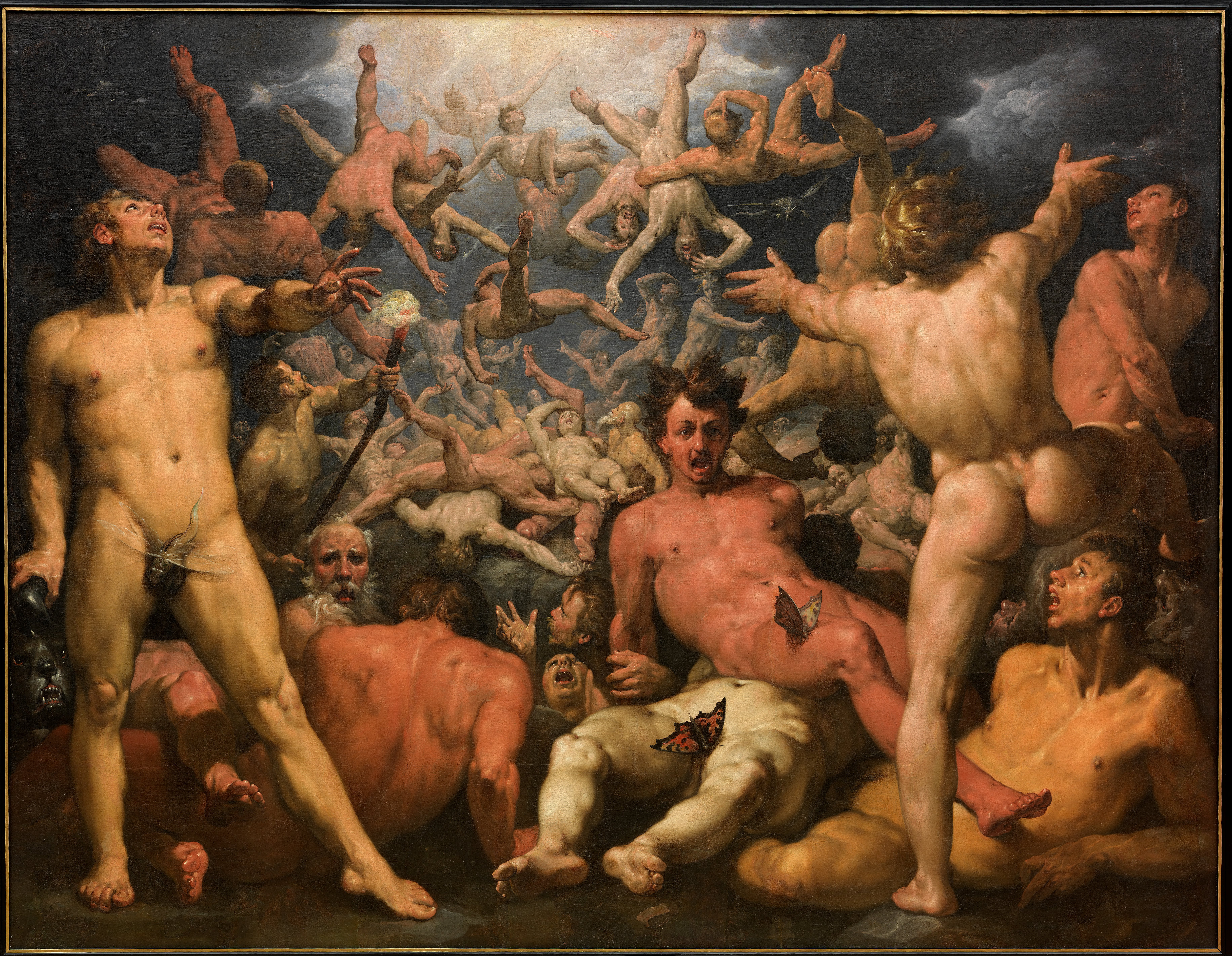|
The Furies
The Erinyes ( ; sing. Erinys ; grc, Ἐρινύες, pl. of ), also known as the Furies, and the Eumenides, were female chthonic deities of vengeance in ancient Greek religion and mythology. A formulaic oath in the ''Iliad'' invokes them as "the Erinyes, that under earth take vengeance on men, whosoever hath sworn a false oath". Walter Burkert suggests that they are "an embodiment of the act of self-cursing contained in the oath". They correspond to the Dirae in Roman mythology. The Roman writer Maurus Servius Honoratus wrote (ca. 400 AD) that they are called "Eumenides" in hell, "Furiae" on Earth, and "Dirae" in heaven. Erinyes are akin to some other Greek deities, called Poenai. According to Hesiod's ''Theogony'', when the Titan Cronus castrated his father, Uranus, and threw his genitalia into the sea, the Erinyes (along with the Giants and the Meliae) emerged from the drops of blood which fell on the Earth (Gaia), while Aphrodite was born from the crests of sea foam. ... [...More Info...] [...Related Items...] OR: [Wikipedia] [Google] [Baidu] |
Klytaimnestra Erinyes Louvre Cp710
Clytemnestra (; grc-gre, Κλυταιμνήστρα, ''Klytaimnḗstrā'', ), in Greek mythology, was the wife of Agamemnon, king of Mycenae, and the twin sister of Helen of Troy. In Aeschylus' ''Oresteia'', she murders Agamemnon – said by Euripides to be her second husband – and the Trojan princess Cassandra, whom Agamemnon had taken as a war prize following the sack of Troy; however, in Homer's ''Odyssey'', her role in Agamemnon's death is unclear and her character is significantly more subdued. Name Her Greek name ''Klytaimnḗstra'' is also sometimes Latinized as Clytaemnestra. It is commonly glossed as "famed for her suitors". However, this form is a later misreading motivated by an erroneous etymological connection to the verb ''mnáomai'' (, "woo, court"). The original name form is believed to have been ''Klytaimḗstra'' () without the ''-n-''. The present form of the name does not appear before the middle Byzantine period. Homeric poetry shows an awareness of bo ... [...More Info...] [...Related Items...] OR: [Wikipedia] [Google] [Baidu] |
Aeneid
The ''Aeneid'' ( ; la, Aenē̆is or ) is a Latin Epic poetry, epic poem, written by Virgil between 29 and 19 BC, that tells the legendary story of Aeneas, a Troy, Trojan who fled the Trojan_War#Sack_of_Troy, fall of Troy and travelled to Italy, where he became the ancestor of the Ancient Rome, Romans. It comprises 9,896 lines in dactylic hexameter. The first six of the poem's twelve books tell the story of Aeneas' wanderings from Troy to Italy, and the poem's second half tells of the Trojans' ultimately victorious war upon the Latins (Italic tribe), Latins, under whose name Aeneas and his Trojan followers are destined to be subsumed. The hero Aeneas was already known to Greco-Roman legend and myth, having been a character in the ''Iliad''. Virgil took the disconnected tales of Aeneas' wanderings, his vague association with the foundation of Ancient Rome, Rome and his description as a personage of no fixed characteristics other than a scrupulous ''pietas'', and fashioned th ... [...More Info...] [...Related Items...] OR: [Wikipedia] [Google] [Baidu] |
Alexandria
Alexandria ( or ; ar, ٱلْإِسْكَنْدَرِيَّةُ ; grc-gre, Αλεξάνδρεια, Alexándria) is the second largest city in Egypt, and the largest city on the Mediterranean coast. Founded in by Alexander the Great, Alexandria grew rapidly and became a major centre of Hellenic civilisation, eventually replacing Memphis, in present-day Greater Cairo, as Egypt's capital. During the Hellenistic period, it was home to the Lighthouse of Alexandria, which ranked among the Seven Wonders of the Ancient World, as well as the storied Library of Alexandria. Today, the library is reincarnated in the disc-shaped, ultramodern Bibliotheca Alexandrina. Its 15th-century seafront Qaitbay Citadel is now a museum. Called the "Bride of the Mediterranean" by locals, Alexandria is a popular tourist destination and an important industrial centre due to its natural gas and oil pipelines from Suez. The city extends about along the northern coast of Egypt, and is the largest city on t ... [...More Info...] [...Related Items...] OR: [Wikipedia] [Google] [Baidu] |
Hades
Hades (; grc-gre, ᾍδης, Háidēs; ), in the ancient Greek religion and myth, is the god of the dead and the king of the underworld, with which his name became synonymous. Hades was the eldest son of Cronus and Rhea, although this also made him the last son to be regurgitated by his father. He and his brothers, Zeus and Poseidon, defeated their father's generation of gods, the Titans, and claimed rulership over the cosmos. Hades received the underworld, Zeus the sky, and Poseidon the sea, with the solid earth, long the province of Gaia, available to all three concurrently. In artistic depictions, Hades is typically portrayed holding a bident and wearing his helm with Cerberus, the three-headed guard dog of the underworld, standing to his side. The Etruscan god Aita and the Roman gods Dis Pater and Orcus were eventually taken as equivalent to Hades and merged into Pluto, a Latinisation of Plouton ( grc-gre, , Ploútōn), itself a euphemistic title often given to Had ... [...More Info...] [...Related Items...] OR: [Wikipedia] [Google] [Baidu] |
Aphrodite
Aphrodite ( ; grc-gre, Ἀφροδίτη, Aphrodítē; , , ) is an ancient Greek goddess associated with love, lust, beauty, pleasure, passion, and procreation. She was syncretized with the Roman goddess . Aphrodite's major symbols include myrtles, roses, doves, sparrows, and swans. The cult of Aphrodite was largely derived from that of the Phoenician goddess Astarte, a cognate of the East Semitic goddess Ishtar, whose cult was based on the Sumerian cult of Inanna. Aphrodite's main cult centers were Cythera, Cyprus, Corinth, and Athens. Her main festival was the Aphrodisia, which was celebrated annually in midsummer. In Laconia, Aphrodite was worshipped as a warrior goddess. She was also the patron goddess of prostitutes, an association which led early scholars to propose the concept of "sacred prostitution" in Greco-Roman culture, an idea which is now generally seen as erroneous. In Hesiod's ''Theogony'', Aphrodite is born off the coast of Cythera from the foam (, ) ... [...More Info...] [...Related Items...] OR: [Wikipedia] [Google] [Baidu] |
Gaia (mythology)
In Greek mythology, Gaia (; from Ancient Greek , a poetical form of , 'land' or 'earth'),, , . also spelled Gaea , is the personification of the Earth and one of the Greek primordial deities. Gaia is the ancestral mother—sometimes parthenogenic—of all life. She is the mother of Uranus (the sky), from whose sexual union she bore the Titans (themselves parents of many of the Olympian gods), the Cyclopes, and the Giants; as well as of Pontus (the sea), from whose union she bore the primordial sea gods. Her equivalent in the Roman pantheon was Terra.''Larousse Desk Reference Encyclopedia'', The Book People, Haydock, 1995, p. 215. Etymology The Greek name Γαῖα (''Gaia'' or ) is a mostly epic, collateral form of Attic (''Gē'' ), and Doric (''Ga'' ), perhaps identical to (''Da'' ), both meaning "Earth". The word is of uncertain origin. Beekes suggested a Pre-Greek origin. Robert S. P. Beekes, ''Etymological Dictionary of Greek'', Brill, 2009, pp. 269–270 (''s.v. ... [...More Info...] [...Related Items...] OR: [Wikipedia] [Google] [Baidu] |
Meliae
In Greek mythology, the Meliae (also called Meliads) (; grc, Μελίαι, or , ) were usually considered to be the nymphs of the ash tree, whose name they shared. Mythology According to Hesiod, the Meliae (probably meaning all tree-nymphs) were born from the drops of blood that fell on Gaia arthwhen Cronus castrated Uranus. In Hesiod's ''Works and Days'', the ash trees, perhaps meaning the Melian nymphs, are said to have been the progenitors of the generation of men belonging to Hesiod's Bronze Age. The Meliae were nurses of the infant Zeus in the Cretan Dikti mountains, according to the 3rd century BC poet Callimachus, ''Hymn to Zeus'', where they fed him on the milk of the goat Amalthea and honey. Callimachus appears to make the Theban nymph Melia, who was, by Apollo, the mother of Tenerus and Ismenus, one of the "earth-born" Meliae. Elsewhere, however, this Melia is an Oceanid, one of the many daughters of Oceanus and Tethys.Pindar, ''Paean 9'' fr. 52k 38–46; Paus ... [...More Info...] [...Related Items...] OR: [Wikipedia] [Google] [Baidu] |
Giants (Greek Mythology)
In Greek and Roman mythology, the Giants, also called Gigantes (Greek: Γίγαντες, ''Gígantes'', Γίγας, ''Gígas''), were a race of great strength and aggression, though not necessarily of great size. They were known for the Gigantomachy (or Gigantomachia), their battle with the Olympian gods. According to Hesiod, the Giants were the offspring of Gaia (Earth), born from the blood that fell when Uranus (Sky) was castrated by his Titan son Cronus. Archaic and Classical representations show Gigantes as man-sized hoplites (heavily armed ancient Greek foot soldiers) fully human in form. Later representations (after c. 380 BC) show Gigantes with snakes for legs. In later traditions, the Giants were often confused with other opponents of the Olympians, particularly the Titans, an earlier generation of large and powerful children of Gaia and Uranus. The vanquished Giants were said to be buried under volcanoes and to be the cause of volcanic eruptions and earthquakes. O ... [...More Info...] [...Related Items...] OR: [Wikipedia] [Google] [Baidu] |
Uranus (mythology)
In Greek mythology, Uranus ( ), sometimes written Ouranos ( grc, Οὐρανός, , sky, ), is the personification of the sky and one of the Greek primordial deities. According to Hesiod, Uranus was the son and husband of Gaia (Earth), with whom he fathered the first generation of Titans. However, no cult addressed directly to Uranus survived into Classical times, and Uranus does not appear among the usual themes of Greek painted pottery. Elemental Earth, Sky, and Styx might be joined, however, in solemn invocation in Homeric epic. Uranus is associated with the Roman god Caelus and the Jewish god Yahweh. Etymology Most linguists trace the etymology of the name to a Proto-Greek form ''*Worsanós'' (), enlarged from *''ṷorsó-'' (also found in Greek ''()'' 'to urinate', Sanskrit ''varṣá'' 'rain', Hittite ''ṷarša-'' 'fog, mist').Robert S. P. Beekes, ''Etymological Dictionary of Greek'', vol. 2 (Leiden: Brill, 2009), 1128–1129. The basic Indo-European root is ''* ... [...More Info...] [...Related Items...] OR: [Wikipedia] [Google] [Baidu] |
Cronus
In Ancient Greek religion and mythology, Cronus, Cronos, or Kronos ( or , from el, Κρόνος, ''Krónos'') was the leader and youngest of the first generation of Titans, the divine descendants of the primordial Gaia (Mother Earth) and Uranus (Father Sky). He overthrew his father and ruled during the mythological Golden Age, until he was overthrown by his own son Zeus and imprisoned in Tartarus. According to Plato, however, the deities Phorcys, Cronus, and Rhea were the eldest children of Oceanus and Tethys. Cronus was usually depicted with a harpe, scythe or a sickle, which was the instrument he used to castrate and depose Uranus, his father. In Athens, on the twelfth day of the Attic month of Hekatombaion, a festival called Kronia was held in honour of Cronus to celebrate the harvest, suggesting that, as a result of his association with the virtuous Golden Age, Cronus continued to preside as a patron of the harvest. Cronus was also identified in classical antiqui ... [...More Info...] [...Related Items...] OR: [Wikipedia] [Google] [Baidu] |
Titan (mythology)
In Greek mythology, the Titans ( grc, οἱ Τῑτᾶνες, ''hoi Tītânes'', , ''ho Tītân'') were the pre-Olympian gods. According to the ''Theogony'' of Hesiod, they were the twelve children of the primordial parents Uranus (Sky) and Gaia (Earth), with six male Titans— Oceanus, Coeus, Crius, Hyperion, Iapetus, and Cronus—and six female Titans, called the Titanides or "Titanesses" (, ''hai Tītānídes'')—Theia, Rhea, Themis, Mnemosyne, Phoebe, and Tethys. Cronus mated with his older sister Rhea, who then bore the first generation of Olympians: the six siblings Zeus, Hades, Poseidon, Hestia, Demeter, and Hera. Certain descendants of the Titans, such as Prometheus, Helios, and Leto, are sometimes also called Titans. The Titans were the former gods: the generation of gods preceding the Olympians. They were overthrown as part of the Greek succession myth, which tells how Cronus seized power from his father Uranus and ruled the cosmos with his fellow Titans b ... [...More Info...] [...Related Items...] OR: [Wikipedia] [Google] [Baidu] |
Theogony
The ''Theogony'' (, , , i.e. "the genealogy or birth of the gods") is a poem by Hesiod (8th–7th century BC) describing the origins and genealogies of the Greek gods, composed . It is written in the Epic dialect of Ancient Greek and contains 1022 lines. Descriptions Hesiod's ''Theogony'' is a large-scale synthesis of a vast variety of local Greek traditions concerning the gods, organized as a narrative that tells how they came to be and how they established permanent control over the cosmos. It is the first known Greek mythical cosmogony. The initial state of the universe is chaos, a dark indefinite void considered a divine primordial condition from which everything else appeared. Theogonies are a part of Greek mythology which embodies the desire to articulate reality as a whole; this universalizing impulse was fundamental for the first later projects of speculative theorizing. Further, in the "Kings and Singers" passage (80–103) Hesiod appropriates to himself the authority u ... [...More Info...] [...Related Items...] OR: [Wikipedia] [Google] [Baidu] |








